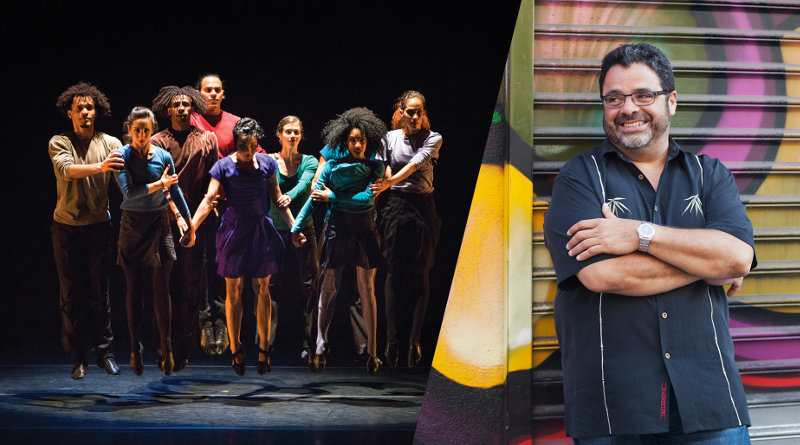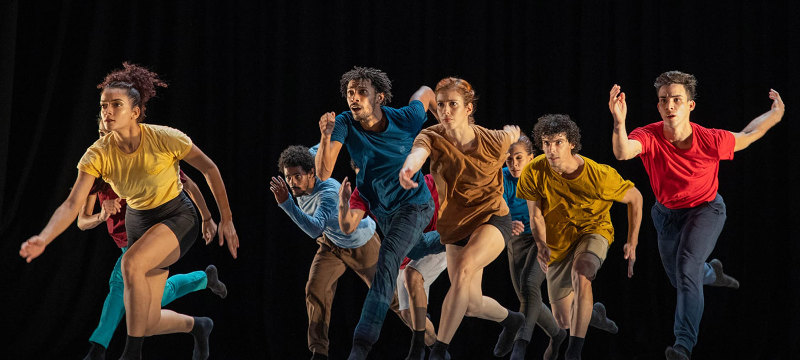
Ed. note: This story by dance critic Debra Levine, commissioned and originally published by the Younes & Soraya Nazarian Center for the Arts, is reprinted with permission.
The havoc Hurricane Ian wreaked on the Caribbean and Florida, in an indirect way, nearly extended all the way to The Soraya’s stage. The endearing Cuban dancers, Malpaso Dance Company, whose much-anticipated debut at The Soraya happens on Thursday, October 13, just avoided getting snagged by the Category 5 storm.
Joining the party—and it will be a party—is the sizzling big band, Arturo O’Farrill and the Afro Latin Jazz Ensemble. This will be the seven-time Grammy Award-winning O’Farrill’s third live Soraya appearance; and he has conducted his music on a shared stage with Malpaso half a dozen times globally. This rare evening of cubanísimo arranged by Soraya Executive and Artistic Director Thor Steingraber celebrates not only the island nation’s marvelous madness with music and dance, but the exceptional resilience of the Cuban people.
While preparing this article, eleven Malpaso dancers, their executive director, and stage manager, all from Cuba, were sheltering in place in Santo Domingo, monitoring the storm squalls pummeling friends and family left behind in Cuba. The nerve-wracking prospect that the storm would derail Malpaso’s much-planned tenth anniversary tour was closely tracked by Ross LeClair of Joyce Theater Productions, who oversaw arrangements. LeClair’s weather-watch capped a similarly harrowing week on the geo-political front.
That’s because prior to Hurricane Ian came Hurricane Donald. “In 2017, the Trump Administration effectively closed the U.S. Embassy in Cuba, citing Havana Syndrome as the reason,” LeClair reminds us, speaking by phone from New York. “Consequently, the Malpaso dancers can no longer apply for U.S. visas while at home. We have had to pivot and identify cities they can get to from Havana and that have an American consulate. We looked at Canada and all around.”
Malpaso already had performances booked in the Dominican Republic, “so we put them up in Santo Domingo for Consulate interviews there,” said LeClair. “Usually it’s pretty fast. This time we had administrative delays. ” (The mandatory in-person interviews ascertain that visa-holders will not overstay in the U.S.) The extra costs were unwelcome dings on the tour’s balance sheet.
Malpaso was booked to transit Miami International Airport. LeClair had to scramble to find thirteen seats on direct flights into Newark and JFK. “We had a tightening window to get them to their first show at Penn State University,” he said, hiding the fact that he was sweating bullets. Following shows at the Joyce Theater in New York, Malpaso will journey to Los Angeles.

Malpaso is a rare, successful independent dance company in a nation of state-sponsored art. Its signature work, the creation of resident choreographer Osnel Delgado, bears the humorous title, “24 Horas Y Un Perro/24 Hours and A Dog.” The work’s original music is by O’Farrill, a brilliant pianist and a son of Cuba once removed (his father, the composer-arranger Chico O’Farrill, was a Cuban émigré). Reviewing “24 + Dog” in the New York Times, dance critic Siobhan Burke called it “a major draw,” and its O’Farrill score, a “ripe, radiant [and] highly danceable composition.”
A wiry dancer whose mop top of black curls lately shorn to a close-cropped look, Delgado is a former gymnast from a dancing tribe. “I come from a family of dancers, my parents are dancers, my mother a teacher at the national school, and I grew up in dance school,” he said in a recent interview. Among the top technically proficient graduates of Escuela Nacional Cubana de Ballet, Delgado entered a feeder tube to Danza Contemporánea de Cuba. In that company, he performed from 2003-2011. The following year, he and two DCC colleagues, Daile Carrazana and Fernando Saéz, broke away and formed the fledgling Malpaso, whose witty name translates as ‘misstep.’ Delgado’s work draws upon American modern dance and Afro-Cuban dance elements and rhythms—with an accent of the Cuban syncretic religious traditions and practices of Santeria and Yoruban culture.
“I love telling stories through the body,” says Delgado, while noting that “Cuba is very good for rhythms, but I don’t think there are so many [dance] creators.” That challenge—the dearth of local choreographers—Linda Shelton of the Joyce Theater Foundation met with vigor, buffeted by the Obama administration’s normalization of U.S./Cuban relations. The Joyce began to fund creative residencies for select choreographers in Havana.
The Canadian-born Aszure Barton was among them. Barton’s newest work for Malpaso, her second for the company, is “Stillness in Bloom,” a Soraya co-commission. With its themes around isolation and reunion, “Stillness” will have its North American premiere at The Soraya. Barton characterized her time in Havana as “beautiful and an absolute pleasure. I have rarely felt so at home in the studio and in a place. The Cuban dancers are passionate and committed to our art form.” What most impressed Barton was working with dancers who are so “deeply human.”
Two artists perhaps familiar to Soraya dance fans, the Brooklyn-based Ronald K. Brown, an expert in African dance, and Sonya Tayeh, who was lead choreographer for the Martha Graham Dance Company’s remounting of “Canticle for Innocent Comedians” (a Soraya world premiere) recently chatted on YouTube about their experience in Havana. Brown admitted “a kind of love at first sight” with Malpaso, stating that the “interpersonal relationships between the dancers, the physicality, was nothing I had seen before.” Tayeh called the dancers “incredible and visceral.” She also relished their surprisingly strenuous work ethic. Arriving by morning at the studios, she was startled to find dancers who were “already sweating,” having completed a ballet class by eight a.m. During long rehearsal days, she recalled with a smile, it was she who was asking, “Isn’t it lunch hour? Aren’t you thirsty?”—not the dancers!
Brown made of this a self-reflective joke. “The way they approached rehearsal told me I am not crazy with my expectations,” he said with a laugh. Brown found “mutual reciprocity” between choreographer and dancer, while musing that, in New York, “I’m the boss yelling, begging, and pulling.” Tayeh added, “I left Cuba thinking, I want that kind of discipline in the room.”
In the half-dozen times that the seven-time Grammy Award-winning O’Farrill has shared the stage with Malpaso, he says he has felt surging joy. But one time, in 2018, that joy morphed to a higher plane, something O’Farrill calls “one of the most powerful moments in my life.” The epiphany happened in Hamburg, Germany. “I remember looking at the movement on stage and hearing the music,” he says, chatting on a Zoom call from UCLA, where he is a Professor of Global Jazz Studies.
“There was a crystal-clear moment, when I could see the music and I could hear the dance. It ceased to be music and it ceased to be dancing. It was this incredible shared magic that I couldn’t see where the music stopped and the dance began. It just organically became whole in a way that I’ve never experienced with just music.”
Arturo O’Farrill
This precious evening of cubanisimo at The Soraya is sweeter for all the struggle. O’Farrill says, “Cubans are mad-good at inventing joy. They can party out of a glass of water. They can repair a Chevy with a Band-Aid and a paper clip. They stand on line for blocks to get a piece of bread; I mean, they are suffering. But even in the most barren of existences, these folks are genius at finding the joy in living.”
Malpaso Dance Company with Arturo O’Farrill and the Afro Latin Jazz Ensemble | The Soraya | Oct 13
In 2023, Los Angeles arts journalist Debra Levine celebrates 15 years of arts●meme, the fine-arts blog she founded in 2008.
